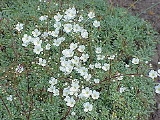
Saxifrage
Encyclopedia
Saxifraga is the largest genus
in the family Saxifragaceae
, containing about 440 species
of Holarctic
perennial plant
s, known as saxifrages. The Latin word saxifraga means literally "stone-breaker", from Latin
("rock" or "stone") + ("to break"). It is usually thought to indicate a medicinal use for treatment of urinary calculi, rather than breaking rocks apart.
The genera Saxifragopsis
(saxifragopsises), Saxifragella are sometimes included in Saxifraga. In recent DNA based phylogenetic analyses of the Saxifragaceae
, the sections Micranthes and Merkianae are shown to be more closely related to the Boykinia
and Heuchera
clades, and the most recent floras separate these groups as the genus Micranthes.
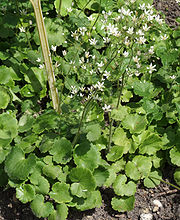 Most saxifrages are smallish plants whose leaves
Most saxifrages are smallish plants whose leaves
grow close to the ground, often in a rosette
. The leaves typically have a more or less incised margin; they may be succulent, needle-like and/or hairy, reducing evaporation
. Charles Darwin
– erroneously believing Saxifraga to be allied to the sundew family (Droseraceae
) – suspected the sticky-leaved Round-leaved Saxifrage (S. rotundifolia), Rue-leaved Saxifrage (S. tridactylites
) and Pyrenean Saxifrage (S. umbrosa) to be protocarnivorous plant
s and conducted some experiment
s whose results supported his observations, but the matter has apparently not been studied since his time.
The inflorescence
s or single flowers are raised above the main plant body at flowering time on stalks devoid of true leaves. The small actinomorphic hermaphrodite
flowers have five petal
s and sepal
s and are usually white, but red to yellow in some species. As in other primitive eudicots, some of the 5 or 10 stamen
s may appear petal-like.
ecosystem
s, and are hardly ever found outside the temperate
parts of the Northern Hemisphere
; most members of this genus are found in subarctic
climates. A good number of species grow in glacial habitat, such as S. biflora which can be found some 4000 metres (13,123.4 ft) above sea level in the Alps
, or the East Greenland Saxifrage (S. nathorstii). The genus is also abundant in the Eastern
and Western Himalayan alpine shrub and meadows
. Though the archetypal saxifrage is a small plant huddling between rocks
high up on a mountain, many species do not occur in such habitat
and are larger (though still rather delicate) plants found on wet meadow
s.
Various Saxifraga species are used as food plants by the caterpillar
s of some butterflies and moths
, such as the Phoebus Apollo (Parnassius phoebus
).
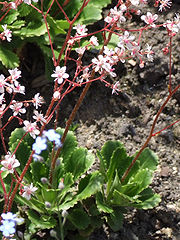 S. × urbium, the hybrid between Pyrenean Saxifrage (S. umbrosa) and Saint Patrick's Cabbage (S. spathularis), is known as London Pride
S. × urbium, the hybrid between Pyrenean Saxifrage (S. umbrosa) and Saint Patrick's Cabbage (S. spathularis), is known as London Pride
and commonly grown as an ornamental plant
. Another horticultural hybrid is Robertsoniana Saxifrage (S. × geum), derived from Kidney Saxifrage (S. hirsuta) and Pyrenean Saxifrage. Some wild species are also used in gardening. Saxifrages are popular cushion plant
s for rock garden
s in temperate and cold climates. Cambridge University Botanic Garden
hosts the United Kingdom
's national collection of saxifrages.
Purple Saxifrage (S. oppositifolia) is a popular floral emblem
. It is the territorial flower of Nunavut
(Canada
) and the county flower of County Londonderry
in the UK. Known as ("red saxifrage") in Norway, it also it is the county flower of Nordland
. Tsukuba
in Japan
has as its city flower hoshizaki-yukinoshita (Katakana
: ホシザキユキノシタ), the aptera form
of Creeping Saxifrage (S. stolonifera). The leaves of the Japanese variety "yukinoshita" (literally "Under the snow") can also been eaten, and is consumed at least within the large southern island of Kyushu. It is prepared buy frying the younger succulent leaves in tempura batter.
In literature, saxifrages do not figure prominently – that is, outside scientific writing such as the studies of Adolf Engler
or the landmark The Structure and Biology of Arctic Flowering Plants
. White Mountain Saxifrage (S. paniculata) is discussed in Nicholas Culpeper
's 1652 herbal
The English Physitian. Well-known references to saxifrages in literature
are:

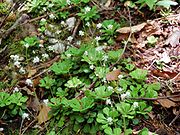

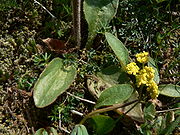
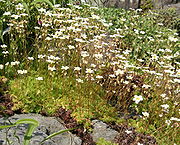
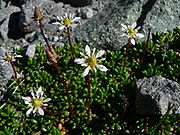

. They include:
have names referring saxifrages although they might not be close relatives of Saxifraga. They include:
Some plants refer to Saxifraga in their generic names or specific epithets, either because they are also "rock-breaking" or because they resemble members of the saxifrage genus:
Genus
In biology, a genus is a low-level taxonomic rank used in the biological classification of living and fossil organisms, which is an example of definition by genus and differentia...
in the family Saxifragaceae
Saxifragaceae
Saxifragaceae is a plant family with about 460 known species in 36 genera. In Europe there are 12 genera.The flowers are hermaphroditic and actinomorphic...
, containing about 440 species
Species
In biology, a species is one of the basic units of biological classification and a taxonomic rank. A species is often defined as a group of organisms capable of interbreeding and producing fertile offspring. While in many cases this definition is adequate, more precise or differing measures are...
of Holarctic
Holarctic
The Holarctic ecozone refers to the habitats found throughout the northern continents of the world as a whole. This region is divided into the Palearctic, consisting of Northern Africa and all of Eurasia, with the exception of Southeast Asia and the Indian subcontinent, and the Nearctic,...
perennial plant
Perennial plant
A perennial plant or simply perennial is a plant that lives for more than two years. The term is often used to differentiate a plant from shorter lived annuals and biennials. The term is sometimes misused by commercial gardeners or horticulturalists to describe only herbaceous perennials...
s, known as saxifrages. The Latin word saxifraga means literally "stone-breaker", from Latin
Latin
Latin is an Italic language originally spoken in Latium and Ancient Rome. It, along with most European languages, is a descendant of the ancient Proto-Indo-European language. Although it is considered a dead language, a number of scholars and members of the Christian clergy speak it fluently, and...
("rock" or "stone") + ("to break"). It is usually thought to indicate a medicinal use for treatment of urinary calculi, rather than breaking rocks apart.
The genera Saxifragopsis
Saxifragopsis
Saxifragopsis is a monotypic genus of flowering plants in the saxifrage family containing the single species Saxifragopsis fragarioides, which is known by the common name strawberry saxifrage. This plant is sometimes included in genus Saxifraga...
(saxifragopsises), Saxifragella are sometimes included in Saxifraga. In recent DNA based phylogenetic analyses of the Saxifragaceae
Saxifragaceae
Saxifragaceae is a plant family with about 460 known species in 36 genera. In Europe there are 12 genera.The flowers are hermaphroditic and actinomorphic...
, the sections Micranthes and Merkianae are shown to be more closely related to the Boykinia
Boykinia
Boykinia is a small genus of plants related to the saxifrages. It contains about 8 species known as brookfoams. Brookfoams are glandular rhizomatous creeping perennials with highly lobed or toothed leaves and inflorescences of petite flowers...
and Heuchera
Heuchera
The genus Heuchera includes at least 50 species of herbaceous perennial plants in the family Saxifragaceae, all native to North America. Common names include alumroot and coral bells. They have palmately lobed leaves on long petioles, and a thick, woody rootstock...
clades, and the most recent floras separate these groups as the genus Micranthes.
Description

Leaf
A leaf is an organ of a vascular plant, as defined in botanical terms, and in particular in plant morphology. Foliage is a mass noun that refers to leaves as a feature of plants....
grow close to the ground, often in a rosette
Rosette (botany)
In botany, a rosette is a circular arrangement of leaves, with all the leaves at a single height.Though rosettes usually sit near the soil, their structure is an example of a modified stem.-Function:...
. The leaves typically have a more or less incised margin; they may be succulent, needle-like and/or hairy, reducing evaporation
Evaporation
Evaporation is a type of vaporization of a liquid that occurs only on the surface of a liquid. The other type of vaporization is boiling, which, instead, occurs on the entire mass of the liquid....
. Charles Darwin
Charles Darwin
Charles Robert Darwin FRS was an English naturalist. He established that all species of life have descended over time from common ancestry, and proposed the scientific theory that this branching pattern of evolution resulted from a process that he called natural selection.He published his theory...
– erroneously believing Saxifraga to be allied to the sundew family (Droseraceae
Droseraceae
Droseraceae is the botanical name for a family of flowering plants. The family is also known under its common name, the sundew family.It consists of carnivorous plants: besides the sundews, the genus Drosera, it also contains the even more-famous Venus fly trap Dionaea muscipula...
) – suspected the sticky-leaved Round-leaved Saxifrage (S. rotundifolia), Rue-leaved Saxifrage (S. tridactylites
Saxifraga tridactylites
Saxifraga tridactylites, the Rue-leaved Saxifrage or "nailwort", is a species of plant in the family Saxifragaceae....
) and Pyrenean Saxifrage (S. umbrosa) to be protocarnivorous plant
Protocarnivorous plant
A protocarnivorous plant , according to some definitions, traps and kills insects or other animals but lacks the ability to either directly digest or absorb nutrients from its prey like a carnivorous plant...
s and conducted some experiment
Experiment
An experiment is a methodical procedure carried out with the goal of verifying, falsifying, or establishing the validity of a hypothesis. Experiments vary greatly in their goal and scale, but always rely on repeatable procedure and logical analysis of the results...
s whose results supported his observations, but the matter has apparently not been studied since his time.
The inflorescence
Inflorescence
An inflorescence is a group or cluster of flowers arranged on a stem that is composed of a main branch or a complicated arrangement of branches. Strictly, it is the part of the shoot of seed plants where flowers are formed and which is accordingly modified...
s or single flowers are raised above the main plant body at flowering time on stalks devoid of true leaves. The small actinomorphic hermaphrodite
Hermaphrodite
In biology, a hermaphrodite is an organism that has reproductive organs normally associated with both male and female sexes.Many taxonomic groups of animals do not have separate sexes. In these groups, hermaphroditism is a normal condition, enabling a form of sexual reproduction in which both...
flowers have five petal
Petal
Petals are modified leaves that surround the reproductive parts of flowers. They often are brightly colored or unusually shaped to attract pollinators. Together, all of the petals of a flower are called a corolla. Petals are usually accompanied by another set of special leaves called sepals lying...
s and sepal
Sepal
A sepal is a part of the flower of angiosperms . Collectively the sepals form the calyx, which is the outermost whorl of parts that form a flower. Usually green, sepals have the typical function of protecting the petals when the flower is in bud...
s and are usually white, but red to yellow in some species. As in other primitive eudicots, some of the 5 or 10 stamen
Stamen
The stamen is the pollen producing reproductive organ of a flower...
s may appear petal-like.
Ecology
Saxifrages are typical inhabitants of Arctic-alpineArctic-alpine
An arctic-alpine taxon is one whose natural distribution includes the Arctic and more southerly mountain ranges, particularly the Alps. The presence of identical or similar taxa in both the tundra of the far north, and high mountain ranges much further south is testament to the similar...
ecosystem
Ecosystem
An ecosystem is a biological environment consisting of all the organisms living in a particular area, as well as all the nonliving , physical components of the environment with which the organisms interact, such as air, soil, water and sunlight....
s, and are hardly ever found outside the temperate
Temperate
In geography, temperate or tepid latitudes of the globe lie between the tropics and the polar circles. The changes in these regions between summer and winter are generally relatively moderate, rather than extreme hot or cold...
parts of the Northern Hemisphere
Northern Hemisphere
The Northern Hemisphere is the half of a planet that is north of its equator—the word hemisphere literally means “half sphere”. It is also that half of the celestial sphere north of the celestial equator...
; most members of this genus are found in subarctic
Subarctic
The Subarctic is a region in the Northern Hemisphere immediately south of the true Arctic and covering much of Alaska, Canada, the north of Scandinavia, Siberia, and northern Mongolia...
climates. A good number of species grow in glacial habitat, such as S. biflora which can be found some 4000 metres (13,123.4 ft) above sea level in the Alps
Alps
The Alps is one of the great mountain range systems of Europe, stretching from Austria and Slovenia in the east through Italy, Switzerland, Liechtenstein and Germany to France in the west....
, or the East Greenland Saxifrage (S. nathorstii). The genus is also abundant in the Eastern
Eastern Himalayan alpine shrub and meadows
The Eastern Himalayan alpine shrub and meadows is a montane grasslands and shrublands ecoregion of Bhutan, China, India, Myanmar, and Nepal, which lies between the tree line and snow line in the eastern portion of the Himalaya Range.-Setting:...
and Western Himalayan alpine shrub and meadows
Western Himalayan alpine shrub and meadows
The Western Himalayan alpine shrub and meadows is an montane grasslands and shrublands ecoregion of Nepal, India, and Tibet, which lies between the tree line and snow line in the western portion of the Himalaya Range.-Setting:...
. Though the archetypal saxifrage is a small plant huddling between rocks
Cushion plant
A cushion plant is a compact, low growing, mat forming plant that is found in alpine, subalpine, arctic, or subarctic environments around the world...
high up on a mountain, many species do not occur in such habitat
Habitat
* Habitat , a place where a species lives and grows*Human habitat, a place where humans live, work or play** Space habitat, a space station intended as a permanent settlement...
and are larger (though still rather delicate) plants found on wet meadow
Meadow
A meadow is a field vegetated primarily by grass and other non-woody plants . The term is from Old English mædwe. In agriculture a meadow is grassland which is not grazed by domestic livestock but rather allowed to grow unchecked in order to make hay...
s.
Various Saxifraga species are used as food plants by the caterpillar
Caterpillar
Caterpillars are the larval form of members of the order Lepidoptera . They are mostly herbivorous in food habit, although some species are insectivorous. Caterpillars are voracious feeders and many of them are considered to be pests in agriculture...
s of some butterflies and moths
Lepidoptera
Lepidoptera is a large order of insects that includes moths and butterflies . It is one of the most widespread and widely recognizable insect orders in the world, encompassing moths and the three superfamilies of butterflies, skipper butterflies, and moth-butterflies...
, such as the Phoebus Apollo (Parnassius phoebus
Parnassius phoebus
Parnassius phoebus, known as the Phoebus Apollo or Small Apollo, is a butterfly species of the family of Swallowtail butterflies found in Eurasia and North America.P...
).
Use by humans

London Pride (flower)
London Pride, Saxifraga x urbium, is a perennial garden flowering plant. Alternative names for it include St. Patrick's Cabbage, Whimsey, Prattling Parnell, and Look Up And Kiss Me.-Taxonomy:...
and commonly grown as an ornamental plant
Ornamental plant
Ornamental plants are plants that are grown for decorative purposes in gardens and landscape design projects, as house plants, for cut flowers and specimen display...
. Another horticultural hybrid is Robertsoniana Saxifrage (S. × geum), derived from Kidney Saxifrage (S. hirsuta) and Pyrenean Saxifrage. Some wild species are also used in gardening. Saxifrages are popular cushion plant
Cushion plant
A cushion plant is a compact, low growing, mat forming plant that is found in alpine, subalpine, arctic, or subarctic environments around the world...
s for rock garden
Rock Garden
The Rock Garden or Rock Garden of Chandigarh is a Sculpture garden in Chandigarh, India, also known as Nek Chand's Rock Garden after its founder Nek Chand, a government official who started the garden secretly in his spare time in 1957. Today it is spread over an area of forty-acres , it is...
s in temperate and cold climates. Cambridge University Botanic Garden
Cambridge University Botanic Garden
The Cambridge University Botanic Garden is a botanical garden located in Cambridge, England. It lies between Trumpington Road to the west and Hills Road to the east, close to Cambridge railway station. The garden covers an area of 16 hectares...
hosts the United Kingdom
United Kingdom
The United Kingdom of Great Britain and Northern IrelandIn the United Kingdom and Dependencies, other languages have been officially recognised as legitimate autochthonous languages under the European Charter for Regional or Minority Languages...
's national collection of saxifrages.
Purple Saxifrage (S. oppositifolia) is a popular floral emblem
Floral emblem
In a number of countries, plants have been chosen as symbols to represent specific geographic areas. Some countries have a country-wide floral emblem; others in addition have symbols representing subdivisions. Different processes have been used to adopt these symbols - some are conferred by...
. It is the territorial flower of Nunavut
Nunavut
Nunavut is the largest and newest federal territory of Canada; it was separated officially from the Northwest Territories on April 1, 1999, via the Nunavut Act and the Nunavut Land Claims Agreement Act, though the actual boundaries had been established in 1993...
(Canada
Canada
Canada is a North American country consisting of ten provinces and three territories. Located in the northern part of the continent, it extends from the Atlantic Ocean in the east to the Pacific Ocean in the west, and northward into the Arctic Ocean...
) and the county flower of County Londonderry
County Londonderry
The place name Derry is an anglicisation of the old Irish Daire meaning oak-grove or oak-wood. As with the city, its name is subject to the Derry/Londonderry name dispute, with the form Derry preferred by nationalists and Londonderry preferred by unionists...
in the UK. Known as ("red saxifrage") in Norway, it also it is the county flower of Nordland
Nordland
is a county in Norway in the North Norway region, bordering Troms in the north, Nord-Trøndelag in the south, Norrbottens län in Sweden to the east, Västerbottens län to the southeast, and the Atlantic Ocean to the west. The county was formerly known as Nordlandene amt. The county administration is...
. Tsukuba
Tsukuba, Ibaraki
is a city located in Ibaraki Prefecture, Japan. It is known as the location of the , a planned city developed in the 1960s.As of 2008, the city has an estimated population of 207,394 and a population density of 730 persons per km². Its total area is 284.07 km².Mount Tsukuba, particularly well-known...
in Japan
Japan
Japan is an island nation in East Asia. Located in the Pacific Ocean, it lies to the east of the Sea of Japan, China, North Korea, South Korea and Russia, stretching from the Sea of Okhotsk in the north to the East China Sea and Taiwan in the south...
has as its city flower hoshizaki-yukinoshita (Katakana
Katakana
is a Japanese syllabary, one component of the Japanese writing system along with hiragana, kanji, and in some cases the Latin alphabet . The word katakana means "fragmentary kana", as the katakana scripts are derived from components of more complex kanji. Each kana represents one mora...
: ホシザキユキノシタ), the aptera form
Form (botany)
In botanical nomenclature, a form is one of the "secondary" taxonomic ranks, below that of variety, which in turn is below that of species; it is an infraspecific taxon...
of Creeping Saxifrage (S. stolonifera). The leaves of the Japanese variety "yukinoshita" (literally "Under the snow") can also been eaten, and is consumed at least within the large southern island of Kyushu. It is prepared buy frying the younger succulent leaves in tempura batter.
In literature, saxifrages do not figure prominently – that is, outside scientific writing such as the studies of Adolf Engler
Adolf Engler
Heinrich Gustav Adolf Engler was a German botanist. He is notable for his work on plant taxonomy and phytogeography, like Die Natürlichen Pflanzenfamilien , edited with Karl A. E...
or the landmark The Structure and Biology of Arctic Flowering Plants
The structure and biology of Arctic flowering plants
The Structure and Biology of Arctic Flowering Plants is a classical scientific work on morphology and anatomy in relation to the harsh arctic environment. It was initiated by Eugenius Warming and conducted by himself and a suite of students and colleagues at the University of Copenhagen.Warming, E....
. White Mountain Saxifrage (S. paniculata) is discussed in Nicholas Culpeper
Nicholas Culpeper
Nicholas Culpeper was an English botanist, herbalist, physician, and astrologer. His published books include The English Physician and the Complete Herbal , which contain a rich store of pharmaceutical and herbal knowledge, and Astrological Judgement of Diseases from the Decumbiture of the Sick ,...
's 1652 herbal
Herbal
AThe use of a or an depends on whether or not herbal is pronounced with a silent h. herbal is "a collection of descriptions of plants put together for medicinal purposes." Expressed more elaborately — it is a book containing the names and descriptions of plants, usually with information on their...
The English Physitian. Well-known references to saxifrages in literature
Literature
Literature is the art of written works, and is not bound to published sources...
are:
- In William Carlos WilliamsWilliam Carlos WilliamsWilliam Carlos Williams was an American poet closely associated with modernism and Imagism. He was also a pediatrician and general practitioner of medicine, having graduated from the University of Pennsylvania...
' poem "A Sort of a Song", Williams refers to his idea of perception (to see through the metaphorical rock, see into the essence of the object, "no ideas but in things") when he writes Invent! Saxifrage is my flower that splits the rocks. - In Kim Stanley RobinsonKim Stanley RobinsonKim Stanley Robinson is an American science fiction writer known for his award-winning Mars trilogy. His work delves into ecological and sociological themes regularly, and many of his novels appear to be the direct result of his own scientific fascinations, such as the fifteen years of research...
's Mars trilogyMars trilogyThe Mars trilogy is a series of award-winning science fiction novels by Kim Stanley Robinson that chronicles the settlement and terraforming of the planet Mars through the intensely personal and detailed viewpoints of a wide variety of characters spanning almost two centuries...
, the character Sax Russell – an atomic physicist sent to MarsMarsMars is the fourth planet from the Sun in the Solar System. The planet is named after the Roman god of war, Mars. It is often described as the "Red Planet", as the iron oxide prevalent on its surface gives it a reddish appearance...
as part of Earth's first colony attempt on that planet – is named after this plant. There are several references to the saxifrage genus, and Robinson uses the plant's common name "stonebreaker" and descriptions of the flower to describe aspects of Russell's personality. - In The Song of BernadetteThe Song of Bernadette (novel)The Song of Bernadette is a 1942 novel that tells the story of Saint Bernadette Soubirous, who, from February to July 1858 in Lourdes, France, reported eighteen visions of the Blessed Virgin Mary. The novel was written by Franz Werfel and was published in 1942...
, Franz WerfelFranz WerfelFranz Werfel was an Austrian-Bohemian novelist, playwright, and poet.- Biography :Born in Prague , Werfel was the first of three children of a wealthy manufacturer of gloves and leather goods. His mother, Albine Kussi, was the daughter of a mill owner...
described Saint Bernadette Soubirous as eating saxifrage in response to a request from Our Lady of LourdesOur Lady of LourdesOur Lady of Lourdes is the name used to refer to the Marian apparition said to have appeared before various individuals on separate occasions around Lourdes, France...
to "eat of the plants" near where she was about to dig for the Lourdes Spring. The real Saint Bernadette did eat plants and said "the lady" had asked her to. Several devotional writers identified the plants as saxifrage, and the location of the Lourdes Grotto, in a huge outcropping in the Pyrenees, makes it plausible.
Selected species







- Saxifraga adscendens – Ascending Saxifrage
- Saxifraga aizoidesSaxifraga aizoidesSaxifraga aizoides is a flower of the genus Saxifraga. Yellow mountain saxifrage prefers cold and wet shale cliff environment and could be found in North America and Europe .-External links and references:***...
– Yellow Mountain Saxifrage, Yellow Saxifrage - Saxifraga aizoon
- Saxifraga algisii
- Saxifraga anadyrensis
- Saxifraga androsacea
- Saxifraga aquatica
- Saxifraga apricaSaxifraga apricaSaxifraga aprica is a species of saxifrage known by the common name Sierra saxifrage. It is native to the high mountains of California, including the Sierra Nevada and the southern Cascade Range, and adjacent slopes in southern Oregon and western Nevada. It grows in mountain habitat in areas of...
– Sierra Saxifrage - Saxifraga arachnoidea
- Saxifraga aspera
- Saxifraga biflora
- Saxifraga bronchialis L. – Matte Saxifrage
- Saxifraga bryophoraSaxifraga bryophoraSaxifraga bryophora is a species of saxifrage known by the common name bud saxifrage. It is native to the western United States, where its two varieties are geographically separated. The more common var. bryophora is endemic to the mountains of California, and the rare var...
- Saxifraga caesia
- Saxifraga californicaSaxifraga californicaSaxifraga californica is a species of saxifrage known by the common name California saxifrage. It is native to much of California west of the deserts, as well as adjacent sections of southern Oregon and northern Baja California. It grows in many types of moist habitat from the coast to the mountains...
- Saxifraga callosa Sm.
- Saxifraga canaliculata
- Saxifraga careyana
- Saxifraga carpatica
- Saxifraga cernua – Drooping Saxifrage, Nodding Saxifrage, Bulblet Saxifrage
- Saxifraga cervicornis
- Saxifraga cespitosa – Tufted Saxifrage
- Saxifraga ciliata
- Saxifraga cochlearis
- Saxifraga columnaris Schmalh.
- Saxifraga corsica
- Saxifraga cuneifoliaSaxifraga cuneifoliaSaxifraga cuneifolia, common name Lesser London Pride or Shield-leaved Saxifrage or Spoon-leaved Saxifrage, is a herbaceous perennial plant belonging to the Saxifragaceae family.-Etymology:...
– Lesser London Pride - Saxifraga cymbalaria – Celandine Saxifrage
- Saxifraga decipiens
- Saxifraga dinnikii Schmalh.
- Saxifraga eschscholtzii – Cushion Saxifrage
- Saxifraga exarata
- Saxifraga ferrugineaSaxifraga ferrugineaSaxifraga ferruginea is a species of saxifrage known by the common names russethair saxifrage and rusty saxifrage. It is native to western North America from Alaska and northwestern Canada to northern California to Wyoming, where it can be found in moist, rocky habitat in mountainous areas...
Graham – Rustyhair Saxifrage - Saxifraga flagellarisSaxifraga flagellarisSaxifraga flagellaris is a plant native all over the high arctic and some areas of northern Rocky Mountains, and Norway. It is not very common. It is also known as Spider Saxifrage or "spider plant", though the latter name more commonly refers to the unrelated Chlorophytum comosum . The Broadsepal...
Willd. ex Sternb. – Whiplash Saxifrage, Spider Saxifrage, "spider plant" - Saxifraga florulenta
- Saxifraga foliolosa – Leafy Saxifrage
- Saxifraga forbesei
- Saxifraga fortunei Hook.f.
- Saxifraga gaspensis – Gaspé Saxifrage
- Saxifraga × geum – Robertsoniana Saxifrage (S. hirsuta × S. umbrosa)
- Saxifraga granulataSaxifraga granulataSaxifraga granulata is a flowering plant of the genus Saxifraga in the family Saxifragaceae.-References:...
– Meadow Saxifrage - Saxifraga groenlandica
- Saxifraga hederacea
- Saxifraga hieracifoliaSaxifraga hieracifoliaSaxifraga hieracifolia is a species of saxifrage distributed all over the high arctic and some alpine areas like Norway and the Carpathian Mountains, with a few isolated populations in the Central Eastern Alps of Austria and the Massif Central of...
– Hawkweed-leaved Saxifrage, Stiff-stemmed Saxifrage - Saxifraga hirculus L. – Yellow Marsh Saxifrage, Marsh Saxifrage, "bog saxifrage"
- Saxifraga hirsuta – Kidney Saxifrage
- Saxifraga howelliiSaxifraga howelliiSaxifraga howellii is a species of saxifrage known by the common name Howell's saxifrage. It is endemic to the Klamath Mountains of southern Oregon and northern California, where it grows in moist, rocky habitat. It is a perennial herb growing from a caudex, usually with a rhizome system...
- Saxifraga hyperborea – Pygmy Saxifrage
- Saxifraga hypnoides – Mossy Saxifrage, Dovedale Moss
- Saxifraga integrifoliaSaxifraga integrifoliaSaxifraga integrifolia is a species of saxifrage known by the common name wholeleaf saxifrage. It is native to western North America from British Columbia to Montana and northern California, where it grows in moist habitat, including meadows, prairies, and grassy mountain slopes...
– Northwestern Saxifrage - Saxifraga juniperifolia
- Saxifraga korshinskii Kom.
- Saxifraga lactea Turcz.
- Saxifraga longifolia
- Saxifraga lyallii Engl. – Redstem Saxifrage
- Saxifraga mertensianaSaxifraga mertensianaSaxifraga mertensiana is a species of plant in the Saxifragaceae family. It is native to western North America.-External links:* Accessed 2008-06-28.****...
– Mertens' Saxifrage - Saxifraga michauxii – Michaux's Saxifrage
- Saxifraga micranthidifoliaSaxifraga micranthidifoliaSaxifraga micranthidifolia is a member of the Saxifrage family with the common name Brook Lettuce. It grows in wet areas and mountain streams....
– Brook Lettuce - Saxifraga montana
- Saxifraga moschata – Musky Saxifrage, "mossy saxifrage"
- Saxifraga moschata ssp. basaltica
- Saxifraga muscoides
- Saxifraga mutata
- Saxifraga nathorstii (Dusén) Hayek – East Greenland Saxifrage
- Saxifraga nelsoniana D.Don – Heartleaf Saxifrage
- Saxifraga nidificaSaxifraga nidificaSaxifraga nidifica is a species of saxifrage known by the common name peak saxifrage. It is native to the northwestern United States, where it grows in moist habitat, often in mountainous areas. It is a perennial herb growing from a caudex and system of rhizomes and producing a basal rosette of...
– Peak Saxifrage, "alpine saxifrage" - Saxifraga nipponica
- Saxifraga nivalisSaxifraga nivalisSaxifraga nivalis is a species of saxifrage. It is commonly called Snow Saxifrage or "alpine saxifrage".Found on irrigated rocks or open vegetation in shaded sites, often on mountain ledges and crags with base rich substratum. This species is not very tolerant of competition and so is found in...
– Snow Saxifrage, "alpine saxifrage" - Saxifraga occidentalis – Western Saxifrage
- Saxifraga odontolomaSaxifraga odontolomaSaxifraga odontoloma is a species of saxifrage known by the common name brook saxifrage. It is native to much of western North America, where it can be found in many types of moist and rocky habitat types. It is a perennial herb growing from a caudex and rhizome system. It produces a clump of...
Piper – Streambank Saxifrage - Saxifraga oppositifolia – Purple Saxifrage, Purple Mountain Saxifrage
- Saxifraga oreganaSaxifraga oreganaSaxifraga oregana is a species of saxifrage known by the common name Oregon saxifrage. It is native to western North America, including the mountainous regions of the western United States. It can be found in moist habitat, such as marshes and other wetlands. It is a perennial herb growing from a...
Howell – Bog Saxifrage - Saxifraga paniculataSaxifraga paniculataSaxifraga paniculata is a species of saxifrage native to the United States.-External links:*...
– White Mountain Saxifrage - Saxifraga pensylvanica L. – Swamp Saxifrage
- Saxifraga petraea
- Saxifraga platysepala (= S. flagellaris auct. non Willd.) – Broadsepal Saxifrage
- Saxifraga porophylla
- Saxifraga razshivinii – Razshivin's Saxifrage
- Saxifraga redofskii – Many-flower Saxifrage
- Saxifraga reflexa – Yukon Saxifrage
- Saxifraga rhomboidea – Diamondleaf Saxifrage
- Saxifraga rivularisSaxifraga rivularisSaxifraga rivularis is a species of saxifrage known by several common names, including alpine brook saxifrage, pygmy saxifrage, and weak saxifrage.-Distribution:...
– Alpine Brook Saxifrage, Brook Saxifrage, Highland Saxifrage - Saxifraga rosacea – Irish Saxifrage
- Saxifraga rotundifolia L. – Round-leaved Saxifrage
- Saxifraga roylei
- Saxifraga rudolphiana
- Saxifraga rufidulaSaxifraga rufidulaSaxifraga rufidula is a species of saxifrage known by the common name rustyhair saxifrage. It is native to western North America from British Columbia to Oregon, and one location in northern California. It grows in moist, open and rocky habitat in mountainous areas. It is a perennial herb growing...
– Redwool Saxifrage - Saxifraga rufopilosa – Redhair Saxifrage
- Saxifraga sancta
- Saxifraga serpyllifolia – Thymeleaf Saxifrage
- Saxifraga sibirica – Siberian Saxifrage
- Saxifraga spathularis – Saint Patrick's Cabbage
- Saxifraga spicata – Spiked Saxifrage
- Saxifraga stellarisSaxifraga stellarisSaxifraga stellaris, the starry saxifrage or hairy kidney-wort, is an Arctic-alpine species of saxifrage. It produces panicles of 5–10 white flowers on a stem up to tall, rising from a basal leaf rosette...
– Starry Saxifrage, Star Saxifrage - Saxifraga stoloniferaSaxifraga stoloniferaSaxifraga stolonifera is a perennial flowering plant known by several common names, including Creeping Saxifrage, Strawberry Saxifrage, Creeping Rockfoil, the quite ambiguous "Aaron's beard", and Strawberry Begonia or Strawberry Geranium...
– Creeping Saxifrage, Strawberry Saxifrage, Creeping Rockfoil, Strawberry Begonia, Strawberry Geranium, "Aaron's beard"- Saxifraga stolonifera f. aptera (Makino) H.Hara – hoshizaki-yukinoshita (Japanese)
- Saxifraga subverticillata
- Saxifraga taygetea
- Saxifraga taylorii – Taylor's Saxifrage
- Saxifraga tenella
- Saxifraga tenuis – Ottertail Pass Saxifrage
- Saxifraga tolmieiSaxifraga tolmieiSaxifraga tolmiei is a species of saxifrage known by the common name Tolmie's saxifrage, or Tolmie's alpine saxifrage. It is native to western North America from Alaska to Montana to California, where it grows in rocky mountain habitat types, especially in alpine climates, such as talus and...
– Tolmie's Saxifrage - Saxifraga tombeanensis
- Saxifraga tricuspidata Rottb. – Prickly Saxifrage
- Saxifraga tridactylitesSaxifraga tridactylitesSaxifraga tridactylites, the Rue-leaved Saxifrage or "nailwort", is a species of plant in the family Saxifragaceae....
– Rue-leaved Saxifrage, "nailwort" - Saxifraga trifurcata
- Saxifraga × urbium – London Pride (S. spathularis × S. umbrosa)
- Saxifraga umbrosa – Pyrenean Saxifrage
- Saxifraga vandelli
- Saxifraga virginiensisSaxifraga virginiensisSaxifraga virginiensis is a wildflower native to eastern and central North America.It is a herbacious plant, which can reach 30cm tall ....
– Early Saxifrage, Virginia Saxifrage - Saxifraga wahlenbergii
Formerly placed here
Plants formerly placed in Saxifraga are mainly but not exclusively SaxifragaceaeSaxifragaceae
Saxifragaceae is a plant family with about 460 known species in 36 genera. In Europe there are 12 genera.The flowers are hermaphroditic and actinomorphic...
. They include:
- Astilboides tabularis, as S. tabularis
- Bergenia crassifoliaBergenia crassifoliaBergenia crassifolia, the badan, Siberian tea, Mongolian tea, leather bergenia, winter-blooming bergenia, heartleaf bergenia, elephant's ears or elephant-ears, is a plant species in the genus Bergenia. It is about 12 inches tall. The leaves are spoon-shaped. One cultivar is Bergenia...
, as S. cordifolia, S. crassifolia - Bergenia pacumbis, as S. ligulata, S. pacumbis
- Bergenia purpurascens, as S. delavayi, S. purpurascens
- Boykinia jamesii, as S. jamesii
- Boykinia occidentalisBoykinia occidentalisBoykinia occidentalis is a species of flowering plant in the saxifrage family known by the common name coastal brookfoam. It is native to the west coast of North America from British Columbia to California, where it grows in shady areas near riverbanks and streams...
(Coastal Brookfoam), as S. elata - Boykinia richardsonii (Richardson's Brookfoam), as S. richardsonii
- Chondrosea cotyledonChondrosea cotyledonChondrosea cotyledon, the Pyramidal Saxifrage, occurs in the mountains of Europe and has rosettes about across of tongue-shaped leaves, beaded but not toothed. In May or June the tall panicles of white flowers, branched and pyramidal in outline, may reach 2'. It is one of Norway's two national...
, as S. cotyledon - Darmera peltata (Indian Rhubarb), as S. peltata
- Leptarrhena pyrolifolia, as S. pyrolifolia
- Luetkea pectinata (Partridgefoot), as S. pectinata
- Mukdenia rossiiMukdenia rossiiMukdenia rossii is a plant in the saxifrage family, Saxifragaceae.-Description:Mukdenia rossii is a herbaceous plant with basal, palmate leaves, on short flowering stems. The flowers are white, borne in spring....
(Mukdenia), as S. rossii
Other "saxifragous" plants
Several plant generaGenera
Genera is a commercial operating system and development environment for Lisp machines developed by Symbolics. It is essentially a fork of an earlier operating system originating on the MIT AI Lab's Lisp machines which Symbolics had used in common with LMI and Texas Instruments...
have names referring saxifrages although they might not be close relatives of Saxifraga. They include:
- Pyramidal Saxifrage, Chondrosea cotyledonChondrosea cotyledonChondrosea cotyledon, the Pyramidal Saxifrage, occurs in the mountains of Europe and has rosettes about across of tongue-shaped leaves, beaded but not toothed. In May or June the tall panicles of white flowers, branched and pyramidal in outline, may reach 2'. It is one of Norway's two national...
- Golden-saxifrages, ChrysospleniumChrysospleniumChrysosplenium is a genus of 57 species of flowering plants in the family Saxifragaceae...
- Burnet-saxifrages, PimpinellaPimpinellaPimpinella is a plant genus in the family Apiaceae; it includes the aromatic herb Anise.-Species:*Pimpinella acuminata*Pimpinella affinis*Pimpinella anisetum*Pimpinella anthriscoides*Pimpinella aromatica*Pimpinella aurea...
- Pepper-saxifrage, Silaum silaus
Some plants refer to Saxifraga in their generic names or specific epithets, either because they are also "rock-breaking" or because they resemble members of the saxifrage genus:
- Campanula saxifraga
- Celmisia saxifraga (Benth.) W.M.Curtis
- Cineraria saxifraga DC.
- Dryopteris saxifraga
- Petrorhagia saxifraga – Tunicflower
- Pimpinella saxifraga – Burnet Saxifrage
- Ptychotis saxifraga
- Saxifragella
- Saxifragodes
- SaxifragopsisSaxifragopsisSaxifragopsis is a monotypic genus of flowering plants in the saxifrage family containing the single species Saxifragopsis fragarioides, which is known by the common name strawberry saxifrage. This plant is sometimes included in genus Saxifraga...
Small

